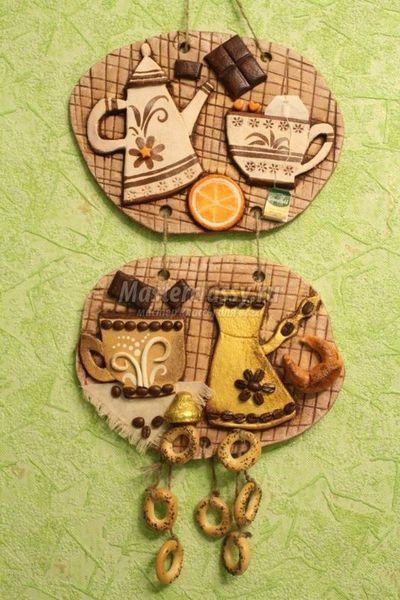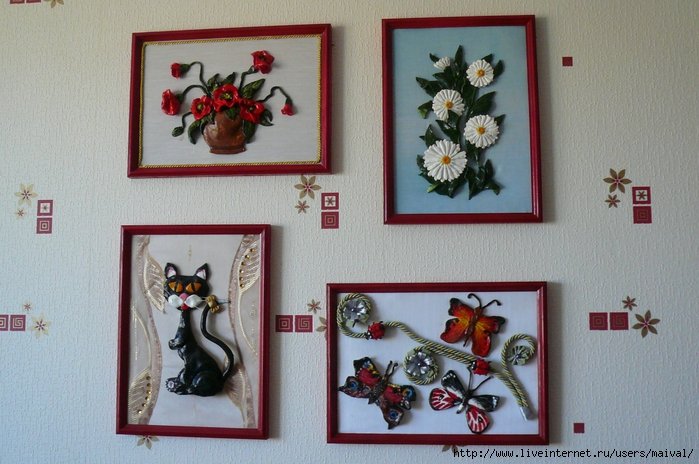Do-it-yourself kitchen panel: how to make an unusual wall decoration using salted dough and cereals
You don't need a lot of materials and skills to make unusual and beautiful accessories and additional elements of your interior. To create an interesting version of the panel for the kitchen with your own hands, you will need a little salted dough and cereals, which can be found in absolutely any home.
Cooking salted dough also does not require special knowledge or skills from the needlewoman. This process can be done even together with children of different ages. To knead the plastic mass of the dough, you do not need to buy special products and ingredients. The finished salt dough product can be painted in completely different colors using acrylic paint, gouache or watercolors.
The process of preparing a mass of salt dough for sculpting panels
To make a mass of salted dough, you need completely simple and affordable products and ingredients. We offer the following easy-to-follow recipe for making salt dough for sculpting figures with your own hands in the piggy bank of your needlework tricks and techniques.
You will need:
- One glass of finely ground salt;
- Two glasses of flour;
- Approximately 125 milliliters of water.
Add one tablespoon of dry wallpaper glue to the mixture of the above ingredients. Instead of dry wallpaper glue, you can use a tablespoon of hand cream or a tablespoon of unrefined vegetable oil.

You can make your salty dough smell and smell good by adding certain spices or herbs to it. For example, it can be cinnamon, nutmeg, cloves, pepper, cumin, and other flavors and spices you love.
You can slightly modify the recipe for making salt dough for modeling. However, one important criterion when mixing a sculpting mixture is the plasticity of the mass. The dough should not stick to your hands and crumble.
The process of making panels for the kitchen with your own hands
Our detailed master class with a step-by-step description of actions will help you make a beautiful and unusual panel for the kitchen with your own hands.
After all the ingredients are collected together and mixed until a homogeneous plastic mass, similar to plasticine, you can immediately begin the process of making a decorative panel for the kitchen. At the next stage, the broadest scope opens up for the manifestation of imagination, creative ideas and artistic abilities.

Decorative panels for the kitchen made of salted dough can be of absolutely any size, shape and color scheme. The only requirement is that the theme of the decoration being created must correspond to the general style of the kitchen space and the given interior. For example, images of the sea, the beach or a person washing in a bath will not be entirely appropriate in the kitchen.
All manipulations are carried out the same as when modeling with plasticine. Large compositions are made using a stencil by cutting and extrusion.

Roll out the dough about half a centimeter thick, put a stencil on it, for example, made of thick cardboard, and cut out the future part of the composition. Here you should be extremely careful and careful, since the cardboard can stick to the salt dough, we recommend not to press too much on it.

During this fun process of creating figurines from salt mass, you can use various tools at hand. We invite you to find out in more detail which items:
- Wooden toothpicks. With their help, you can draw small details in the figures.
- Garlic. Dough can be passed through its holes to shape the hair of the hero of your plot.
- Cooking syringe. Using this object, unusual for modeling, all kinds of decorative details and patterns are created.
- Cookie cutters. With their help, you can cut out the required details and elements of your future composition.
- Buttons. They allow you to make prints on salt dough.
If any salted dough is left over, do not dispose of it right away. You can put the mass in an airtight container and refrigerate. Thus, it will be saved and can be used to create another composition.
It is more expedient to sculpt the figures on a board or baking sheet, where they will subsequently dry out. This will save you from unnecessary washing of devices, and, most importantly, when shifting the elements, they will not be damaged.
It is recommended to varnish the finished panel for the kitchen made of salted dough. Thus, the craft will remain in its original form for a long amount of time.
Video to the article
We suggest watching a small selection of videos on the topic of the article.
